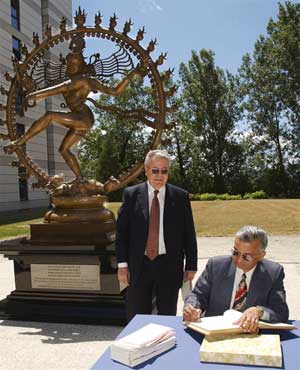Geneva 18 June 2004. At the 128th session of CERN1 Council, held today under the chairmanship of Professor Enzo Iarocci, CERN Director General, Robert Aymar, outlined a seven-point scientific strategy for the Organization. Top of the list was completion of the Large Hadron Collider (LHC) project with start-up on schedule in 2007. This was followed by consolidation of existing infrastructure at CERN to guarantee reliable operation of the LHC, with the third priority being an examination of a possible future experimental programme apart from the LHC.
Geneva 18 June 2004. At the 128th session of CERN1 Council, held today under the chairmanship of Professor Enzo Iarocci, CERN Director General, Robert Aymar, outlined a seven-point scientific strategy for the Organization. Top of the list was completion of the Large Hadron Collider (LHC) project with start-up on schedule in 2007. This was followed by consolidation of existing infrastructure at CERN to guarantee reliable operation of the LHC, with the third priority being an examination of a possible future experimental programme apart from the LHC.
Fourth on Dr Aymar's list of priorities came a role for CERN in the growing coordination of research in Europe. He cited as examples the Coordination of Accelerator Research in Europe (CARE) project, which could contribute to an LHC upgrade by around 2012, and the EUROTEV project through which CERN will participate in generic R&D issues related to a possible future linear collider. Both of these projects are partly financed by the European Union.
The construction, starting in 2006, of a linear accelerator injector at CERN to provide more intense beams for the LHC was Dr Aymar's fifth priority, followed by an accelerated R&D effort towards CLIC, CERN's novel new accelerator technology, which could open the way to much higher energies than are available today. For this to happen, Dr Aymar is appealing to laboratories around the world to join the project, and has so far received 18 expressions of interest. The seventh and final point in the new strategic plan is to prepare a comprehensive review of CERN's long-term activity to be available by 2010, when results from the LHC will have given a first description of the particle physics landscape for years to come.
LHC project leader, Lyn Evans, strongly reaffirmed the intention to start up the LHC in 2007, with first collisions in the summer. Dipoles for two complete octants of CERN's new flagship are at the Laboratory awaiting installation. One of the two transfer lines that will supply proton beams to the LHC is complete and will be tested in October, taking particle beams right to the LHC tunnel. Dr Evans reminded delegates that LHC progress is visible to all through the LHC dashboard accessible from the CERN home page on the World Wide Web. Although there have been some concerns over certain components, all are currently progressing on schedule.
LHC installation is currently being reviewed following a delay in installing the distribution line for the cryogenic liquids that will cool the machine to just 1.9 degrees above absolute zero. Difficulties have been solved, and the contractor has delivered a new installation schedule foreseeing completion of the distribution line by February 2006, with two octants fully installed by the end of this year. This compresses the overall installation schedule, which now requires the installation of two octants at once to make up for the delay.
To conclude his presentation, Dr Evans referred to the global collaboration that is making the LHC a reality. Most of the components from non-Member States are now complete. “It has been a tremendous experience,” concluded Dr Evans, citing this example of strong global collaboration as a model for future accelerator projects.
The Council meeting closed with a ceremony to unveil a statue offered to CERN by the Government of India as a symbol of India's long-standing relationship with CERN. Nataraja, the Cosmic Dancer, depicts a dancing Lord Shiva trampling ignorance. Speaking at the unveiling ceremony, Dr Anil Kakodkar, Chairman of the Indian Atomic Energy Commission and Secretary to the Government of India, expressed his satisfaction that “the Indian scientific community is part of the quest for understanding the Universe”. India's involvement with CERN dates back to the early 1960s.
Report from closed sessions
Reporting from closed sessions of Council in March and this week, Professor Iarocci announced that Council has approved cooperation agreements between CERN and Lithuania, and between CERN, the Hashemite Kingdom of Jordan and the Middle East synchrotron light source, SESAME. Council also approved the appointment of Mrs Carla Bryois (NL) as Head of Human Resources Department for two years from 1 April 2004, and the election of Dr Manuel Aguilar-Benitez (ES) as Vice-President of Council for a term of one year from 1 July 2004.
1. CERN, the European Organization for Nuclear Research, has its headquarters in Geneva. At present, its Member States are Austria, Belgium, Bulgaria, the Czech Republic, Denmark, Finland, France, Germany, Greece, Hungary, Italy, the Netherlands, Norway, Poland, Portugal, the Slovak Republic, Spain, Sweden, Switzerland and the United Kingdom. India, Israel, Japan, the Russian Federation, the United States of America, Turkey, the European Commission and UNESCO have observer status. CERN Council is the body in which the representatives of the 20 Member States of the Organization decide on scientific programmes and financial resources.
